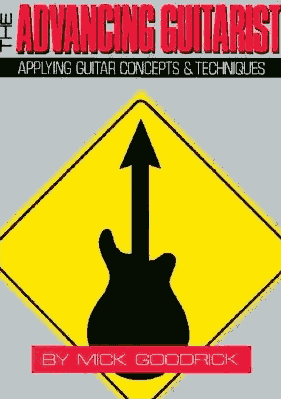
Book Review: Mick Goodrick’s The Advancing Guitarist
Jun 25, 2025A Must-Have... With a Few Caveats
Hey jazz guitarists, today, we’re digging into a true classic. A book that’s whispered about in jazz guitar circles with reverence… sometimes confusion… and often both at once. I’m talking about Mick Goodrick’s The Advancing Guitarist.

First published in the 1980s, this book has been on my shelf (and in my hands) for over 25 years. It’s not your typical method book. In fact, Goodrick pretty much tells you right away: “This is NOT a method. You provide the method. This is the stuff.”
So if you’ve ever felt guilty about not finishing the guitar books on your shelf—don’t worry. This one’s not meant to be finished. It’s meant to be used, revisited, mined for ideas, and pondered over... ideally with your guitar in hand and a strong coffee nearby.
What’s Inside (and Why It’s Not a Method)
Let’s start with the obvious: this book isn’t going to walk you through chord voicings, tunes, or II-V-I licks.
Instead, The Advancing Guitarist opens the door to dozens of ideas—some inspiring, some overwhelming—and asks you to decide what’s relevant. It’s a sandbox for guitar thinkers. You get concepts like:
-
Playing on one string (a huge game-changer for my fretboard visualization).
-
Exploring intervals as a basis for harmony.
-
Rethinking how you play basic scales.
-
Understanding that diads, or two-note combinations, are a powerful lens into harmony.
But beware: if you’re feeling overwhelmed already, this book might make your head spin. It’s better used when you’re stuck in a rut and need a fresh lens—not when you’re drowning in options and just want a to-do list.
What It Doesn’t Teach
Let’s be clear—this book will not teach you standards. It won’t cover II-V-I’s or walking basslines or shell voicings. And for me, that’s a big caveat.
My own teaching philosophy always starts with songs. Standards are the foundation. So while The Advancing Guitarist is packed with interesting explorations, it’s only really useful after you’ve got some tunes under your fingers.
That said—many of the ideas can (and should!) be applied to tunes. It’s up to you to make those connections.
On Exploration: Doing More With What You Know
Goodrick often challenges the idea that “newer is better.” He suggests something radical: do more with what you already know. For example:
Take a simple C major scale. You can play it all on one string. Or two notes per string. Or three. What happens if you go backward across the neck while moving forward through the scale?
It’s not about learning 50 new scales. It’s about seeing one scale 50 different ways.
That idea alone transformed my practice. It made my brain hurt a little at first—but in the best way.
Bonus Fun: The Weird and Wonderful Extras
One of my favorite parts of the book? The “Unrelated Thoughts” section at the end. It’s full of quirky insights like:
-
“What if you recorded yourself today?”
-
“What if you played everything at half-speed?”
-
“What if you didn’t play guitar for a week?”
It’s like Zen Koans for jazz guitarists. Part deep wisdom, part dad joke, all Goodrick.
Other Goodrick Books (If You’re Brave)
If The Advancing Guitarist is the rabbit hole… the other books are Wonderland.
-
Factorial Rhythm (with Mitch Haupers): A book about displacing rhythms in every possible combination. It’s 4/4 meets chess club.
-
Mr. Goodchord’s Almanac: Volumes 1 & 2 are like the Yellow Pages of chord voicings. Volume 1 is Name That Chord... and Volume 2? Do Not Name That Chord. No, seriously.

These books are dense, abstract, and maybe even impractical. But they show the breadth of Goodrick’s imagination. They’re not for the faint of heart—but they’re great for glimpsing the full “deck of cards” when it comes to harmony.
Final Thoughts: Should You Get It?
Yes.
If you're serious about exploring music deeply on guitar—whether jazz or not—The Advancing Guitarist deserves a spot on your shelf.
Will it teach you standards? Nope.
Will it help you become more creative, thoughtful, and original in your playing? Absolutely.
My suggestion: start with learning and playing tunes. Build your core. Then, when you’re ready to break out of the box—Goodrick is waiting.
Until next time—play well, have fun, and don’t forget to explore.
–Marc
JazzGuitarLessons.net









